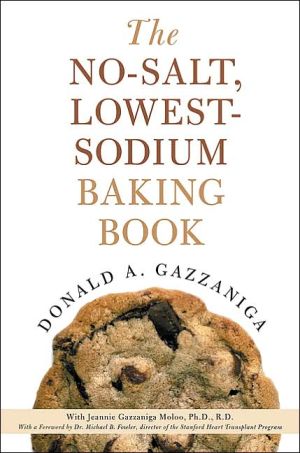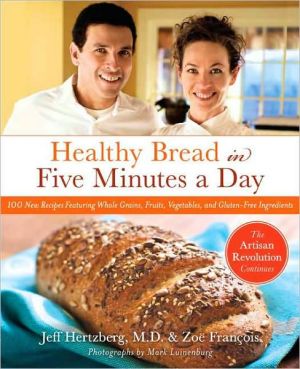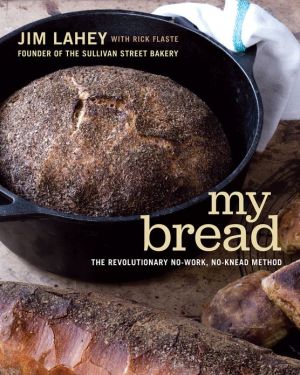No-Salt, Lowest-Sodium Baking Book
Donald Gazzaniga, diagnosed with congestive heart failure, was headed for a heart transplant. Urged by his doctor to keep his sodium intake "under 1,500 to 2,000 milligrams a day," Don headed for the kitchen and went to work devising recipes for delicious low-sodium dishes that added up to less than 500 milligrams daily. The results? Don's name has been removed from the transplant list, and Don shared his recipes with the world in The No-Salt, Lowest-Sodium Cookbook.\ Readers of that first...
Search in google:
Donald Gazzaniga, diagnosed with congestive heart failure, was headed for a heart transplant. Urged by his doctor to keep his sodium intake “under 1,500 to 2,000 milligrams a day,” Don headed for the kitchen and went to work devising recipes for delicious low-sodium dishes that added up to less than 500 milligrams daily. The results? Don’s name has been removed from the transplant list, and Don shared his recipes with the world in The No-Salt, Lowest-Sodium Cookbook.Readers of that first book have kept in touch with Don via his Web site, and have written him letters asking for more. What they most often ask for is a book with more bread recipes, more recipes for cakes and cookies and muffins and tea breads, more of all those great baked things—in short, for the book you now hold in your hands. Don teamed up with his daughter, professional nutritionist Dr. Jeannie Gazzaniga Moloo, to fill The No-Salt, Lowest-Sodium Baking Book with recipes that are as healthy and delicious as possible. As in the previous book, they tell you just how much sodium is in each ingredient. They provide satisfactory substitutes for flavorings that patients with congestive heart failure and high blood pressure shouldn’t have. All easy to make and delicious to eat. Go for it! Library Journal Gazzaniga was diagnosed with congestive heart failure in 1997 and placed on a heart transplant list. While waiting for his transplant, he began developing a diet with recipes that contained little or no sodium. The consequences were twofold: a cookbook aimed at combating heart failure and hypertension and his removal from the transplant list. In this follow-up to The No-Salt, Lowest-Sodium Cookbook, Gazzaniga concentrates on the recipes most requested from his readers, such as bread, pastries, muffins, waffles, and cookies. Over 100 tempting recipes are included-from Don's Best Soft Pretzels and Hearty Cinnamon Bread to Apple Streusel Muffins and Bear Claws. Recipes that call for baking powder require a particular no-sodium brand in order to work correctly, but instructions are given for substituting double-action baking powder if desired. In addition to providing nutritional values and sodium content, each recipe indicates whether it can be adapted for diabetics. Gazzaniga's daughter, Jeannie, a licensed nutritionist, collaborated on this unique title. Recommended for most consumer health and diet collections.-Pauline Baughman, Multnomah Cty. Lib., Portland, OR Copyright 2003 Reed Business Information.
The No-Salt, Lowest-Sodium Baking Book\ \ By Donald A. Gazzaniga \ St. Martin's Griffin\ Copyright © 2004 Donald A. Gazzaniga\ All right reserved.\ ISBN: 9780312335243 \ \ \ \ \ Chapter One\ \ \ Straight Talk from a Cardiologist\ \ \ Dr. Michael B. Fowler, Fellow, Royal College of Physicians\ Stanford Heart Transplant Clinic, Stanford Medical School\ \ \ \ Few patients with heart failure fully appreciate the pivotal role that sodium plays in the severity of their symptoms, and their ability to be free of alarming sensations and avoid hospitalization. Conversely, those individuals who do understand the role of sodium and who adjust their diets to control their sodium intake at consistently low levels frequently experience a dramatic improvement in their general well-being. I have known many patients whose heart failure symptoms were recurrent and so severe that they were advised to undergo heart transplantation, yet these same patients improved so much with sodium restriction that they no longer required a heart transplant. The author of this book is one of those. The diet he himself designed and followed brought his daily sodium intake to under 500 mg and had a profound impact on his ability to live without overt heart failure symptoms and thereby remove his need for a heart transplant.\ Heart failure from any cause is characterized by symptoms that result from retention of sodium (salt is the biggest culprit). Sodium is used by the body to regulate fluid status. In all circumstances that lead to heart failure sodium (and with it water) tends to be retained. In some individuals this may only be apparent at times of additional stress to the heart such as lack of blood-carrying oxygen (leading to angina), change in heart rhythm, intercurrent illnesses such as flu, or when the dietary intake of sodium is especially high (as with pizza). The majority of individuals with heart failure (and many with hypertension) have to combat a constant tendency to retain sodium. Those individuals are generally treated with diuretic drugs.\ All diuretics ("water pills") work by increasing the amount of sodium removed from the bloodstream by the kidneys and from the body by elimination. Most diuretics also cause potassium to be lost, an undesirable side effect often requiring potassium supplementation and/or the use of special potassium-retaining diuretics.\ The amount of sodium loss achieved by a diuretic is largely dependent on the dose of the drug and how often it is taken. The required dose of diuretics is strongly influenced by the dietary sodium intake, although an individual's diuretic requirement in heart failure also varies widely depending on other factors, including the tendency to retain sodium and the individual's sensitivity to the actual diuretics being given.\ It follows that restricting sodium to a constant low level of ingestion is a crucial component to finding and maintaining the correct dose and type of diuretic. Too high a dose will cause a patient to be susceptible to dehydration and lightheadedness, particularly when the dietary sodium intake falls. A more common problem is that even high-dose diuretics may be incapable of removing all the sodium ingested by an individual who does not keep to a carefully regulated and restricted sodium intake. This will result in recurrent episodes of salt and water retention accompanied by breathlessness or abdominal bloating and possible swelling of the ankles. By using this book and sticking to a diet you design, you will achieve a constant level, one that should not alter your lowered level of sodium to the point where your diuretics react in a way you would not desire.\ Individuals who remove all added sodium from their diet, whether that added by the manufacturer or in the patient's own kitchen, will provide the best environment to achieve the maximum improvement in symptoms and a reduced risk of hospitalization. These individuals will also create the clinical stability to achieve the correct doses of other drugs, especially ACE inhibitors and beta blockers necessary for the control of the patient's heart failure.\ Here are some of the symptoms and adverse effects of sodium in heart failure:\ \ \ · Difficulty in breathing, especially when lying flat. Waking at night short of breath. The need to sleep with additional pillows.\ · Weight gain due to extra fluid. Bloating, especially of the abdomen. Swelling of the ankles.\ · Thirst; an excessive desire to drink water.\ · Increased diuretic requirements. "Refractory" sodium retention. Low concentration of sodium in the blood. Loss of potassium.\ · Hospitalization; emergency room visits.\ \ \ The benefits of low sodium achieved by a careful fresh food diet are:\ \ \ · Allows stability of the diuretic dose.\ · Allows stability of potassium replacement measures.\ · Increases the possibility of optimizing the doses of other drugs that lessen the risk of major adverse events.\ \ \ Such a regime usually also results in reduced fat intake (important especially in coronary artery disease or when the patient is overweight).\ Patients with heart failure, especially those who are treated with diuretics or who take diuretics every day, will benefit from restricting their sodium to the few milligrams per day they find in food consisting of, or prepared from, fresh ingredients. The recipes in this book make it clear that there is little hardship when following this important aspect of living well and as long as possible with heart failure.\ Patients who had previously had their dose of diuretics increased to deal with recurrent episodes of decompensated heart failure may become dehydrated and run the risk of reduced kidney function or spells of lightheadedness (or even blackouts) if they abruptly reduce their sodium intake from previously high levels. Patients should discuss these issues with their physicians before making substantial changes in their sodium intake and ensure that they report these changes to their doctor.\ In general, be creative with your cooking ideas and have fun. If you have a "salt tooth," you can learn to prefer low-sodium food just by eating it. Within two months your tastes should adjust to the point where you won't miss the salt. Removing salt can bring out flavors that have been hidden by the salt.\ \ \ Dr. Michael B. Fowler is a leading researcher in the medical field of congestive heart failure (CHF). Since 1982, he has been with the Stanford Heart Transplant Clinic, where he has been involved in research leading to the use of new beta-blockers such as carvedilol (Coreg) and low-sodium diets to help improve the quality of patients' lives as well as the survival rate for those who develop congestive heart failure.\ \ \ Continues... \ \ \ \ Excerpted from The No-Salt, Lowest-Sodium Baking Book by Donald A. Gazzaniga Copyright © 2004 by Donald A. Gazzaniga. Excerpted by permission.\ All rights reserved. No part of this excerpt may be reproduced or reprinted without permission in writing from the publisher.\ Excerpts are provided by Dial-A-Book Inc. solely for the personal use of visitors to this web site. \ \
\ From the Publisher"People compelled to control their sodium intake will welcome The No-Salt, Lowest-Sodium Baking Book."—Booklist\ "Over 100 tempting recipes are included...recommended."—Library Journal\ \ \ \ \ \ Library JournalGazzaniga was diagnosed with congestive heart failure in 1997 and placed on a heart transplant list. While waiting for his transplant, he began developing a diet with recipes that contained little or no sodium. The consequences were twofold: a cookbook aimed at combating heart failure and hypertension and his removal from the transplant list. In this follow-up to The No-Salt, Lowest-Sodium Cookbook, Gazzaniga concentrates on the recipes most requested from his readers, such as bread, pastries, muffins, waffles, and cookies. Over 100 tempting recipes are included-from Don's Best Soft Pretzels and Hearty Cinnamon Bread to Apple Streusel Muffins and Bear Claws. Recipes that call for baking powder require a particular no-sodium brand in order to work correctly, but instructions are given for substituting double-action baking powder if desired. In addition to providing nutritional values and sodium content, each recipe indicates whether it can be adapted for diabetics. Gazzaniga's daughter, Jeannie, a licensed nutritionist, collaborated on this unique title. Recommended for most consumer health and diet collections.-Pauline Baughman, Multnomah Cty. Lib., Portland, OR Copyright 2003 Reed Business Information.\ \








